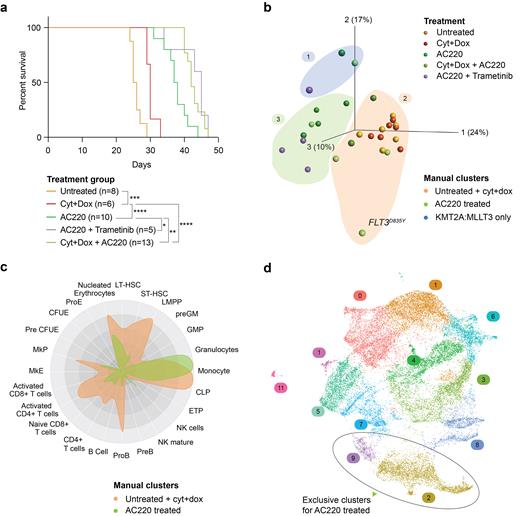Our understanding of how individual mutations, whether present in all or just a subset of the leukemia cells, affect cellular response to therapy is limited. Herein, we investigate the impact of different therapies on survival, evolution, and resistance patterns in an acute myeloid leukemia (AML) mouse model driven by KMT2A::MLLT3 and subclonal FLT3 N676K. Leukemic bone marrow expressing KMT2A::MLLT3-mCherry in all cells and FLT3 N676K-GFP in 40% of cells was re-transplanted into sublethally irradiated recipients. Upon engraftment, recipients were subjected to different treatments, including chemotherapy (cytarabine for 5 days+doxorubicin for 3 days), the FLT3 inhibitor AC220, chemotherapy followed by AC220, or AC220+Trametinib, a MEK inhibitor. Targeted treatment was administered for 28 days, while the control group received vehicle ( Fig 1a).
Each treatment prolonged survival with a median latency of 30 days for chemotherapy 37.5 days for AC220, 42 days for chemotherapy+AC220, and 45 days for AC220+Trametenib, and 25.5 days for control mice. At sacrifice, all mice displayed splenomegaly and leukocytosis. The treatment impacted the evolution of the KMT2A:: MLLT3+ FLT3 N676K cells and they expanded to clonal dominance in control and chemotherapy-treated mice. However, three distinct patterns of evolution were detected in AC220-treated mice with the FLT3 N676K-containing cells either expanding to clonal dominance (>80% of KMT2A:: MLLT3+ FLT3 N676K), the FLT3 N676K-containing cells being eradicated (>80% of KMT2A::MLLT3-alone), or dual similar sized clones expressing KMT2A:: MLLT3-alone or KMT2A::MLLT3+ FLT3 N676K(Fig1 b).Eradication of the FLT3 N676K-cells was rare, predominantly observed upon AC220+Trametinib treatment and the frequency of dual clones increased when chemotherapy was followed by AC220, in line with treatment affecting the evolution of genetically distinct clones.
RNA-sequencing was used to determine altered gene expression patterns upon resistance and unveiled three major clusters including 1) mice expressing KMT2A:: MLLT3-alone, 2) control and chemotherapy-treated mice, and 3) AC220-treated mice. Notably, a subset of AC220-treated mice clustered close to the control and chemotherapy-treated mice suggesting potential resistance mechanisms through activation of the MEK/ERK-pathway. All leukemias had a myeloid Cd11b + phenotype. However, the control and chemotherapy-treated leukemias also displayed an aberrant expression of the lymphoid marker B220 and showed enrichment of gene sets correlating with stemness and oxidative phosphorylation, that suggested a switch in cellular phenotype and metabolic state. In contrast, AC220-treated leukemias lacked or had a low fraction of B220 + cells and showed enrichment of gene sets correlating with granulocyte-monocyte progenitors (GMP) and immune regulatory pathways (Fig 1 c). Acquired AC220-resistance mutations was rare (n=2), suggesting activation of alternative pathways upon resistance. Re-treatment of established cell lines from treated animals with AC220 showed that the cells were resistant.
To uncover mechanisms of resistance at the cellular level, single cell RNA-sequencing was performed on four mice and revealed the emergence of distinct cellular subpopulations in AC220-treated mice, with a strong GMP signature and upregulation of the homeobox gene Six1(Fig 1d).Overexpression of Six1 in all AC220-treated leukemias was further confirmed by bulk RNA-sequencing. Interestingly, Six1 has previously been described as a regulator for leukemia stem cell maintenance in AML and under Wnt/ß-catenin signalling control. Subsequent drug assays showed AC220-treated cells exhibited sensitivity to Six1 pharmacological inhibition, suggesting a dependency on Six1, as well as sensitivity to Wnt/ß-catenin inhibition.
Taken together, the treatment given affected survival and impacted evolution of the FLT3 N676K-leukemia cells. The general absence of acquired mutations in most mice suggests that target-independent mechanisms may underline acquired resistance in most mice, and we propose the Six1/Wnt/ß-catenin axis as a potential vulnerability upon AC220-resistance.
Disclosures
No relevant conflicts of interest to declare.


This feature is available to Subscribers Only
Sign In or Create an Account Close Modal